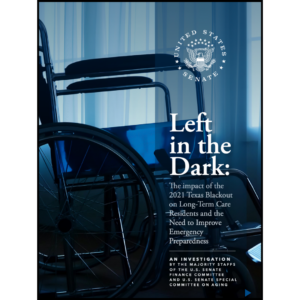7 Steps to Better Disaster Preparedness in Your Long-Term Care Facility
A little planning can go a long way when you’re faced with an emergency.
Whether it’s a hurricane, a tornado, an earthquake, a wildfire, a flood, or a blizzard, natural disasters can threaten your business and the health and safety of your residents.
Similar disruptions result regardless of the specific weather in question, and can include:
- Loss of power
- Loss of phone and/or internet
- Contamination of the local water supply
- Loss of access to fresh food
- Loss of access to medication supplies
All of these problems can pose a huge threat to the safety of your staff and residents. But there are some ways to mitigate the threat of natural disasters, and they all start with the need for a formal plan.
- Write a Plan
Though the threats are many, a little planning ahead of time can vastly improve how your business survives a natural disaster, says Eric R. Alberts, corporate director of Emergency Preparedness, Emergency Management at Orlando Health. “Not having proper measures in place can lead to a poor response to an emergency and result in a loss of life, business and reputation of your organization.”
Since November 2017, the Centers for Medicare & Medicaid Services (CMS) have dictated that all long-term care facilities have a written disaster prep plan in place, says Sue Anne Bell, PhD, SMP-B, an assistant professor at the University of Michigan School of Nursing. This happened around the same time that Hurricane Irma ravaged parts of Florida and laid bare the need to have not just a plan in place, “but also that long-term care facilities conduct at least annual drills for what their plans are. That’s helped a lot,” she says.
Still, being adequately prepared for a disaster is “particularly challenging because disasters are unpredictable. You don’t know if a hurricane is going to pass right over or if it’s going to have a fairly limited impact. Or if you’ll have a situation like Hurricane Harvey in Houston that stalled and caused huge, unprecedented amounts of rainfall and flooding,” Bell says. The after-effects of that flooding in Texas created enormous problems for many residents, some of whom are still trying to recover from the 2017 storm.
- Conduct an HVA
Planning for a disaster isn’t always easy, and Alberts says it’s not uncommon for facility leaders to “feel at a loss and not know where to begin with your disaster preparedness efforts. It’s OK, and you must remember that you have to start somewhere.”
He recommends starting with a hazard vulnerability analysis (HVA) for your organization. “There are many free HVA models you can find online,” but the key is to figure out which hazards are most likely to pose a threat to your organization and start planning for that. (The American Health Care Association/National Center for Assisted Living offers a free, downloadable HVA worksheet.)
- Tap Key Stakeholders
You should also assemble a planning team of “key stakeholders who will have an integral piece of your response to an emergency. This team can assist you with building your emergency preparedness plan, recommend training classes, and help conduct emergency training exercises,” Alberts says.
- Coordinate with Local Emergency Services
Bell adds that while the exact details of your disaster plan are going to be largely dependent on your location and what the local treats are, being ready “boils down to careful coordination with local emergency management.” Be sure you have worked with local emergency services to understand when and how to evacuate your facilities and what resources will be made available in the event of a natural disaster. She recommends reaching out to the joint commission through CMS and regional groups of emergency managers and planners for health care facilities. “Their resources are not just physical, but also knowledge based,” she says.
- Develop a Back-Up Plan
Bell adds that you should also have a “back-up plan in place.” No disaster plan, no matter how well planned can cover all eventualities, so you should opt for the belt-and-suspenders approach and have a plan B option in case plan A isn’t adequate.
- Revisit the Plan Frequently
Lest you think you can set a plan and then forget it, Alberts says your disaster plan is a topic you should revisit frequently. “All of these efforts are continuous and help build a resilient plan, process, and team.” The possibility of certain threats may wax or wane over time, so it’s important to stay cognizant of any changes to the local environment that might mean you need to develop a new plan or adjust what you’ve already created.
- Train for the Response
Lastly, it’s important to disseminate the plan and be sure that your staff and residents are aware of how they should respond in the event of a natural disaster. Occasional drills to check that the system works will also help ensure that your facility is as ready as it can be when the wind kicks up and the rain starts falling.

Elaine K. Howley is a freelance journalist for various publications. An award-winning writer specializing in health, fitness, sports and history, her work has appeared in numerous print and online publications, including U.S. News, AARP.org, espnW, SWIMMER magazine and Atlas Obscura. She’s also a world-record holding marathon swimmer with a passion for animals and beer. Contact her via her website: elainekhowley.com.
Related Articles
Topics: Disaster Preparedness , Facility management , Featured Articles , Operations , Risk Management











